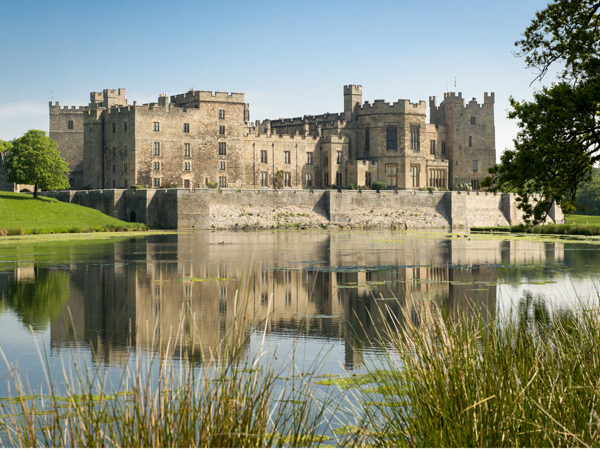Seen from the short approach road, Raby is a formidable sight, a grey stone medieval fortress rising from green parkland. But the view is deceptive, because it never was a castle in the true sense of the word. Rather, it was a very substantial defensible house, built in the 14th century by the Nevill family who lived there until dispossessed in 1569 by Elizabeth I for their part in the Rising of the North. In 1626 Raby was bought from the Crown by Sir Henry Vane, of whom the present owner, the 11th Lord Barnard, is a direct descendant.
Since the beginning of the 18th century the castle has been substantially altered in several phases; first, by James Paine in 1750s; second, by John Carr in the 1770s and 1780s; third, by William Burn in the 1840s. Despite these changes, the castle has retained and even added to its medieval character. For example, the extraordinary Entrance Hall, created by John Carr to allow family and guests to drive by carriage directly into the house, is one of the most dramatic and innovative Gothic revival interiors of its age, while William Burns’ Barons’ Hall and Octagonal Drawing Room are triumphant statements of Gothic and Jacobean revivalism respectively.
On leaving Carr’s grand Entrance Hall we passed down a narrow passage and through a series of lobbies before entering the Small Drawing Room. Here, under a wonderful 18th century plasterwork ceiling of musical trophies, we saw an eclectic mix of 18th and 19th-century furniture and objects, both English and Continental, while on the walls was a fine array of sporting pictures by J.F. Herring, John Wootton and others. The panelled Library next door was a large wood-panelled room remodelled about 1750, also furnished with a range of styles and periods; among the highlights were a longcase clock by George Graham and two huge Chinese carved ivory ornamental pagoda towers. Two things particularly caught our attention; the first was a suite of late Regency chairs of outstanding quality, in the manner of Morel and Hughes, and made in solid kingwood with gilt-brass mounts. The second was a satinwood secretaire cabinet of c.1800 by Thomas Weeks, with its original mechanical barrel-organ in the lower part. It is the only one of the seventeen known such cabinets in working order. In adjoining the Ante-Library was a fine Antwerp cabinet of about 1670, veneered with turtleshell, ebony, ivory and marquetry of various woods. Among the outstanding pictures were oils by David Teniers the Younger and Pieter de Hooch.
The Octagonal Drawing Room was William Burn’s major achievement at Raby and, stepping into it, one felt that it must have looked much the same when first completed in the 1840s. Partly this was due to the fact that much of the furnishing – the pier tables, pier glasses and chandeliers – were original to the room, but it was also the result of careful and painstaking restoration in recent years. Indeed, the whole house is a testament to the care which the present owner has taken to preserve his family’s home for future generations.
The Dining Room contained a large ‘Imperial’ dining table by Gillow and a set of Gillow’s dining chairs, both dating from the 1820s, while either side of the fireplace was a pair of sideboard tables in the style of Thomas Hope. The walls were hung with family portraits by van Dyck, Lely and Reynolds, together with others by Cornelis de Vos, and Jacopo Amiconi.
Upstairs we passed through a series of family bedrooms before arriving at the Baron’s Hall, the climax of our tour. This vast room, originally capable of accommodating seven hundred knights under a giant hammerbeam roof, has been much altered since the 14th century. John Carr first raised the floor by fifteen feet, to accommodate his new entrance hall below, and William Burn then lengthened it by fifty feet and re-roofed it. None of the original furnishings have survived. In their place was a range of different periods and styles, the most striking being the Gothic Revival tables in striped coromandel ebony, perhaps designed by AWN Pugin, and a large Regency suite with giltwood frames by Gillow. Covering part of the floor was the Raby Tapestry, a large 18th century needlework carpet said to have been worked by Lady Grace Fitzroy, wife of the 1st Earl of Darlington. Probably the most remarkable objects of all, however, were the giant Meissen porcelain birds, modelled by Johan Joachim Kandler for the Japanese Palace at Dresden about 1730.
On our way out we passed through the Kitchen, built about 1370 and surely one of the most remarkable rooms at Raby, albeit a purely functional one. This room was in continuous use from c.1370 until 1954. Its most notable feature is the vaulted ceiling centred by a large octagonal lantern which drew the heat, smoke and smells upward and out. At first floor level there were galleries in the immensely thick walls by which food was taken up to the Barons’ Hall.

